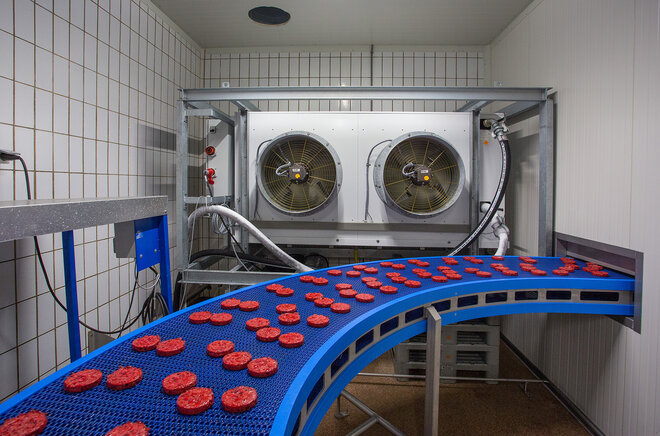Inventory management in the food Industry: strategies for optimization and flexibility

What are the challenges of inventory management in the food industry? In the current rapidly changing world of the food industry, companies often face the challenge of capacity shortages that can limit efficiency and growth.
Key challenges in capacity management in the food industry
Seasonal demand peaks
Seasonality can lead to fluctuations in demand that overwhelm food production capacity, making it difficult for companies to meet peak demand without excessive costs and temperature equipment.
Production interruptions and maintenance periods
Planned maintenance and unexpected production interruptions can reduce operational inventory and have a significant impact on overall productivity.
Flexibility constraints in production lines
Insufficient flexibility in production lines can make it challenging to respond quickly to changing market demand, new product introductions, or changes in production processes.
"Capacity challenges require innovative solutions that maintain the quality, safety and endurance of the inventory."
The impact of inventory management in the food industry
-
Cost savings:
- Efficient inventory management leads to significant cost savings for food businesses. According to a report by Food Logistics, optimized inventory management can reduce carrying costs by up to 25%, resulting in substantial financial benefits.
- By minimizing excess inventory and reducing stockouts, food companies can optimize their working capital, improve cash flow, and allocate resources more efficiently.
-
Demand forecasting:
- Accurate demand forecasting is crucial for effective inventory management in the food industry. A study by the Grocery Manufacturers Association (GMA) found that 80% of inventory management issues are attributed to inaccurate demand forecasting.
- Advanced forecasting techniques, such as predictive analytics and machine learning algorithms, enable food companies to anticipate consumer demand more accurately, thereby optimizing inventory levels and minimizing the risk of overstocking or stockouts.
-
Food waste reduction:
- Effective inventory management plays a pivotal role in reducing food waste throughout the supply chain. The Food and Agriculture Organization (FAO) estimates that approximately one-third of all food produced for human consumption is lost or wasted globally each year.
- By implementing inventory management strategies such as first-in-first-out (FIFO) rotation, batch tracking, and real-time monitoring, food businesses can minimize waste by ensuring the timely utilization of perishable ingredients and products.
-
Technology adoption:
- Technology-driven solutions are transforming inventory management practices in the food industry. According to a survey by Food Logistics, 65% of food companies are investing in inventory management software and automation technologies to improve efficiency and accuracy.
- Inventory management software offers features such as real-time tracking, demand forecasting, automated replenishment, and integration with other supply chain systems, enabling food businesses to optimize inventory levels and streamline operations.
-
Regulatory compliance:
- Compliance with regulatory requirements is a key consideration in food inventory management. Strict regulations govern aspects such as traceability, labeling, and storage conditions to ensure food safety and quality.
- Food companies must maintain accurate inventory records, implement proper labeling and packaging practices, and adhere to storage and handling guidelines prescribed by regulatory bodies such as the Food and Drug Administration (FDA) and the European Food Safety Authority (EFSA).
How to solve capacity shortages?
A pivotal aspect of effective capacity management lies in strategic inventory management coupled with predictive analysis. Anticipating fluctuations in demand and aligning production capacity accordingly can be a game-changer in an industry where responsiveness is key.

Optimal stock levels
By maintaining optimal stock levels, companies can prevent overstocking or understocking issues. This requires a meticulous understanding of demand patterns and the implementation of agile inventory management practices.

Reduced wastage
Strategic inventory management minimizes the risk of perishable goods reaching their expiration dates before being sold.

Data-driven decision-making
Predictive analysis relies on historical data and advanced algorithms to forecast future demand. This data-driven approach enables companies to make informed decisions, aligning their production capacity with anticipated market needs.

Enhanced supply chain coordination
Integrating predictive analysis into supply chain management facilitates better coordination with suppliers and distributors. This collaborative approach ensures that the entire supply chain is responsive to changes in demand, reducing the likelihood of bottlenecks.
Temperature equipment as the key factor for inventory management
As we conclude this exploration of inventory management strategies, it's crucial to recognize the key factor in maintaining both optimal stock levels and preserving product integrity: temperature equipment. The strategic use of temperature equipment seamlessly integrates with strategic inventory management and predictive analysis.
Temperature equipment ensures that perishable goods are stored and transported under ideal conditions, mitigating the risk of spoilage and preserving product quality. In times of peak demand, having access to temporary temperature-controlled storage becomes not just a convenience but a strategic necessity.
Find out how Coolworld solved this challenge for Vandemoortele, a european market leader in bakery products.



